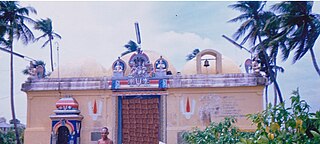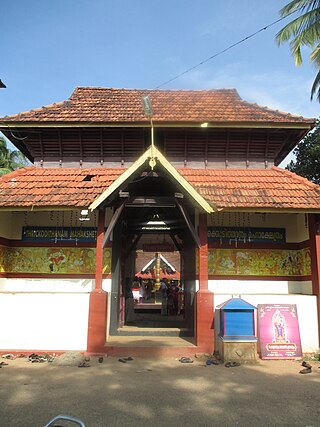
The Aranmula Parthasarathy Temple is a Hindu temple located near Aranmula, a village in Pathanamthitta District, Kerala, South India. It is dedicated to the God Krishna, an avatar of Vishnu, who is worshipped as Parthasarathy. Constructed in the Kerala style of architecture, it is one of the "Divya Desams", the 108 temples of Vishnu revered by the Alvar saints.

Azhagiya Manavalan Perumal Temple in Uraiyur, a suburb Tiruchirappalli in the South Indian state of Tamil Nadu, is dedicated to the Hindu god Vishnu. Constructed in the Dravidian style of architecture, the temple is glorified in the Divya Prabandha, the early medieval Tamil canon of the Alvar saints from the 6th–9th centuries AD. It is one of the 108 Divyadesam dedicated to Vishnu, who is worshipped as Azhagiya Manavalan and his consort Lakshmi as Kamalavalli.

Tiruvekkaa Temple or Yathothkari Perumal Temple is a Hindu temple located in Kanchipuram in the South Indian state of Tamil Nadu and dedicated to the Hindu god Vishnu. Constructed in the Dravidian style of architecture, the temple is glorified in the Naalayira Divya Prabandham, the early medieval Tamil canon of the Alvar saints from the 6th–9th centuries CE. It is one of the 108 Divya Desams dedicated to Vishnu, who is worshipped as Yathothkari Perumal, and his consort Lakshmi as Komalavalli.

Nachiyar Kovil or Thirunarayur Nambi Temple is a Hindu temple in Thirunarayur, a village in the outskirts of Kumbakonam in the southern Indian state of Tamil Nadu, is dedicated to the Hindu god Vishnu and his wife Lakshmi. It is the sub urban region of business city of Kumbakonam.

Sathyamurthi Perumal Temple in Thirumayam, a panchayat town in the South Indian state of Tamil Nadu, is dedicated to the Hindu god Vishnu. Constructed in the Dravidian style of architecture, the temple is glorified in the Nalayira Divya Prabandham, the early medieval Tamil canon of the Alvar saints from the 6th–9th centuries CE. It is one of the 108 Divya Desams dedicated to Vishnu, who is worshipped as Sathyamurthi Perumal and his consort Lakshmi as Ujeevana Thayar.

Puliyoor is a village in Chengannur municipality in Alappuzha district in the Indian state of Kerala.

Devanathaswamy temple in Thiruvanthipuram, a village in the outskirts of Cuddalore in the South Indian state of Tamil Nadu, is dedicated to the Hindu god Vishnu. Constructed in the Dravidian style of architecture, the temple is glorified in the Nalayira Divya Prabandham, the early medieval Tamil canon of the Alvar saints from the 6th–9th centuries CE. It is one of the 108 Divya Desams dedicated to Vishnu, who is worshipped as Devanathaswamy and his consort Lakshmi as Hemabhujavalli. Though the presiding deity is Devanathaswamy, the temple is known for Hayagriva, the horse-faced avatar of Vishnu, and a god of knowledge. The temple is the only historical temple in South India to have a shrine of Hayagriva on hilltop.

Thirumoozhikulam Sree Lakshmanaperumal Temple is located in Thirumoozhikalam (Moozhikkulam) in Ernakulam district of Kerala, India. The temple finds mention in some of verses of ancient Tamil Vedam sung by the Sri Vaishnava Alvars, particularly Nammalvar and Tirumangai Alvar and classified as Divya Desams, the 108 holy temples revered in the canon. This belongs to one of the 13 Malai Naatu (Kerala/Chera) Divya Desams, the Divya Desams located in Kerala.

Thiruchsemponsey or Perarulaalan Perumal Temple is dedicated to Hindu god Vishnu located in Thirunangur, a village in the outskirts of Sirkazhi in the South Indian state of Tamil Nadu. Constructed in the Dravidian style of architecture, the temple is glorified in the Nalayira Divya Prabandham, the early medieval Tamil canon of the Alvar saints from the 6th–9th centuries AD. It is one of the 108 Divya Desam dedicated to Vishnu, who is worshipped as Peralulalan and his consort Lakshmi as Allimalar Nachiyar.

Thiruvaikunda Vinnagaram or Vaikunta Nathan Perumal Temple is dedicated to Hindu god Vishnu located in Tirunangur, a village in the outskirts of Sirkazhi in the South Indian state of Tamil Nadu. Constructed in the Dravidian style of architecture, the temple is glorified in the Nalayira Divya Prabandham, the early medieval Tamil canon of the Alvar saints from the 6th–9th centuries CE. It is one of the 108 Divya Desams dedicated to Vishnu, who is worshipped as Vaikuntanathan and his consort Lakshmi as Vaikuntavalli.

Thiruthevanartthogai or Madhava Perumal Temple is a Hindu temple dedicated to Vishnu located in Tirunangur, a village in the outskirts of Sirkaḻi in the South Indian state of Tamil Nadu. Constructed in the Dravidian style of architecture, the temple is glorified in the Nalayira Divya Prabandham, the early medieval Tamil canon of the Alvar saints from the 6th–9th centuries CE. It is one of the 108 Divya Desams dedicated to Vishnu, who is worshipped as Madhava Perumal and his consort Lakshmi as Kadalmagal.

Ulagalantha Perumal Temple or Trivikrama Temple is a Hindu temple dedicated to Vishnu located in Tirukkoyilur, Tamil Nadu, India. Constructed in the Dravidian style of architecture, the temple is glorified in the Naalayira Divya Prabandham, the early medieval Tamil canon of the Alvar saints from the 6th–9th centuries CE. It is one of the 108 Divya Desams dedicated to Vishnu, who is worshipped as Ulagalantha Perumal and his consort Lakshmi as Poongothai. The temple is believed to have been built by the Medieval Cholas, with later contributions from Vijayanagara kings and Madurai Nayaks. The temple covers an area of 5 acres (20,000 m2) and has a temple tower that is the third tallest in Tamil Nadu, measuring 192 ft (59 m) in height.

The Thrichittatt Mahavishnu Temple is a Hindu temple dedicated to Vishnu,located in Chengannur, Alappuzha District, Kerala, South India. Constructed in the Kerala style of architecture, the temple is glorified in the Nalayira Divya Prabandham, by Nammalvar, one of the Sri Vaishnava saint-poets of the 8th century called the Alvars. It is one of the 108 Divya Desams dedicated to Krishna, an avatar of Vishnu, who is worshipped as Imayavarappan. The nearest railway station to the temple is located in Chengannur, while the nearest airports are Trivandrum International Airport and Nedupumpassery Airport Ernakulam.

The Thiruvanvandoor Mahavishnu Temple is a Hindu temple dedicated to Vishnu and located in Thiruvanvandoor, Alappuzha District, Kerala, South India. Constructed in the Kerala style of architecture, the temple is glorified in the Nalayira Divya Prabandham, the early medieval Tamil canon of the Alvar saints from the 6th–9th centuries CE. It is one of the 108 Divya Desams dedicated to Vishnu, who is worshipped as Paambanaiappan. The nearest railway station to the temple is located in Chengannur, while the nearest airport is Trivandrum International Airport.

Thirumittakode Anchumoorthi Temple is a Hindu temple equally associated with the deities Vishnu and Shiva. Temple is situated on the banks of the Bharathappuzha at Thirumittacode of Palakkad District in Kerala state in India. The five statues - one for Shiva and four Vishnu - are known here as Thirumattikodu five (Anchu) Moorthy Temple.

The Sundaravarada Perumal Temple in Uthiramerur, a village in the South Indian state of Tamil Nadu, is dedicated to the Hindu god Vishnu. Constructed in the Dravidian style of architecture, the temple. Vishnu is worshipped as Sundaravarada Perumal and his consort Lakshmi as Anandavalli. The temple was originally built by Pallavas, with later additions from the Cholas, Pandyas, Sambuvarayas, Vijayanagara Rayas and the Nayaks.

Thrikodithanam Mahavishnu Temple is a Hindu temple dedicated to Vishnu and located in Thrikkodithanam, Kottayam District, Kerala, South India. Constructed in the Kerala style of architecture, the temple is glorified in the Nalayira Divya Prabandham, the early medieval Tamil canon of the Alvar saints from the 6th–9th centuries CE. It is one of the 108 Divya Desam dedicated to Krishna, an avatar of Vishnu, who is worshipped as Mahavishnu. The nearest railway station to the temple is located in Changanassery, while the nearest airport is Cochin International Airport.

Ninra Narayana Perumal Temple or Thiruthankaal in Thiruthangal, a town in the outskirts of Sivakasi in the South Indian state of Tamil Nadu, is dedicated to the Hindu god Vishnu. Constructed in the Dravidian style of architecture, the temple is glorified in the Divya Prabandha, the early medieval Tamil canon of the Alvar saints from the 6th–9th centuries AD. It is one of the 108 Divya Desam dedicated to Vishnu, who is worshipped as Ninra Narayana and his consort Lakshmi as Arunakamala Mahadevi.

The Sowmyanarayana Perumal Temple is located in Thirukoshtiyur, a village in the South Indian state of Tamil Nadu. This ancient temple is dedicated to the Hindu god Vishnu. It is Constructed in the Dravidian style of architecture, the temple is glorified in the Nalayira Divya Prabandham, the early medieval Tamil canon of the Alvar saints from the 6th–9th centuries CE. It is one of the 108 Divya Desams dedicated to Vishnu, who is worshipped as Sowmyanarayana Perumal and his consort Lakshmi as Thirumamagal. The temple is known as the place where Ramanuja, the expounder of Vishishtadvaita philosophy preached the holy ashtakshara "Om Namo Narayanaya" to all people, irrespective of their varna.

The Thiruvazhmarban Temple, also known as Sri Kuralappa Perumal Temple in Thiruppathisaram, a village in Kanyakumari district in the South Indian state of Tamil Nadu, is dedicated to the Hindu god Vishnu. Thiruvazhmarban Temple is located about 5 km far, north-easterly to Nagercoil, 20 km far, north-westerly to Kanyakumari and 45 km south-west of Nanguneri Divya Desam. Constructed in the Dravidian style of architecture, the temple is glorified in the Nalayira Divya Prabandham, the early medieval Tamil canon of the Alvar saints from the 6th–9th centuries CE. It is one of the 108 Divya Desams dedicated to Vishnu, who is worshipped as Thiruvazhmarban and his consort Lakshmi as Kamalavalli. The oldest inscription in the temple is from 1139 CE indicating gifts to the temple. A granite wall surrounds the temple, enclosing all its shrines. The temple tank is located opposite to the temple, outside the main entrance.






















